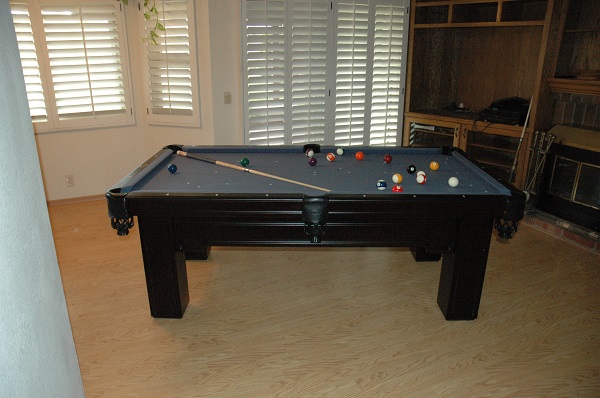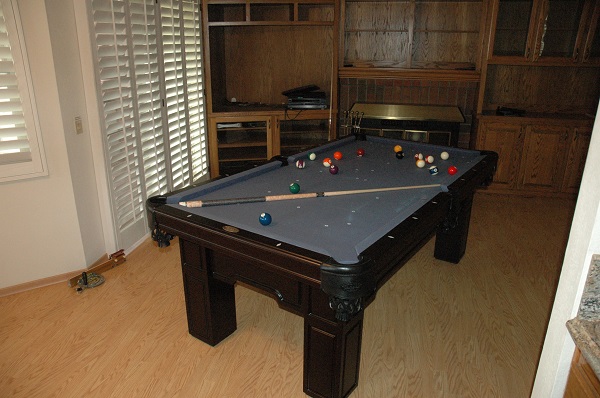Putting a Pool Table in a Small Area
7/15/2014 9:33:43 PM
Putting a Pool Table in a Small Area
I am considering getting a pool table to provide entertainment for friends and family.
However the room I have available is too small for a table but it adjoins another area that, if used, would make most of the pool table playable. The closest obstacle will be in a position where no shot is possible with even the shortest cue.
Does anybody else have this situation? If so, do those obstacles make it not worth having a pool table at all? Is it too frustrating to have an area that is not playable at all?
I am considering two possible layouts, both of which incorporate a seven foot pool table.
What do you think about these two options?
In pool table layout option 1 the pool table is in an orientation that is square with the room. As you can see the lower right corner of the table will be unplayable.
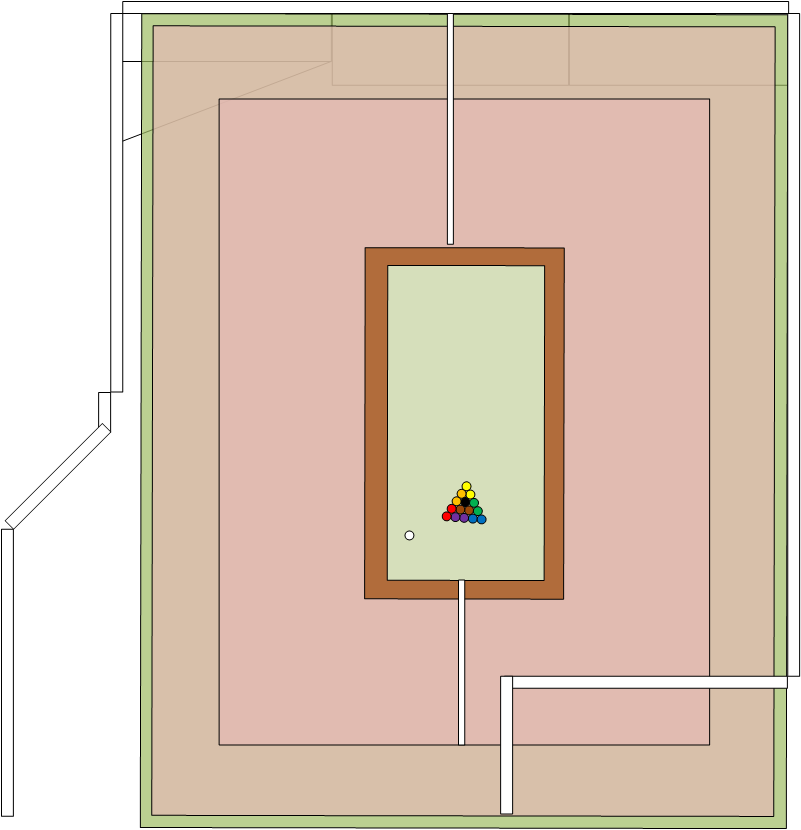
In pool table layout option 2, I realized that the cue does not need full extension at the corners of the table and will sweep a radius as it goes around the table. Using this assumption it may be possible to angle the table and minimize the unplayable area while at the same time moving more towards the center and opening up all four corners for play.
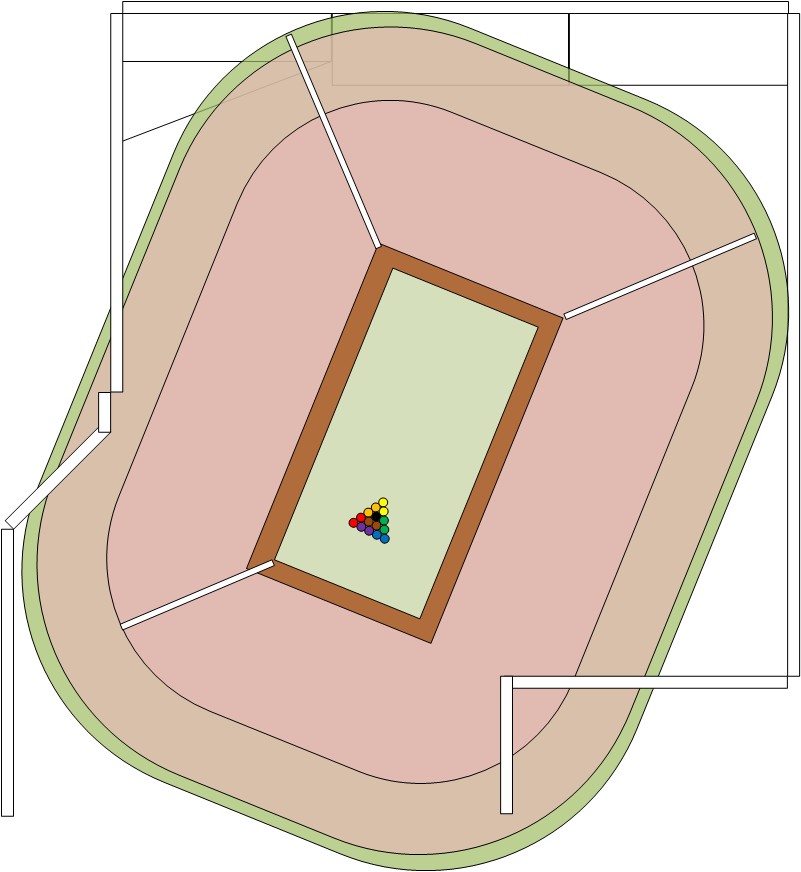
Putting a Pool Table in a Small Area
Replies & Comments
 billiardsforum on 7/29/2014 11:57:01 AM
billiardsforum on 7/29/2014 11:57:01 AMGo with room layout option 2. Yes, both have unplayable areas, but the sum (total surface area) of the "unplayable area" in option 2 is much less than in option 1. Perhaps use option two, and slide the table slightly to the left to distrubute the "unplayable area".
Let us know what you go with.
AlP on 8/10/2014 4:56:11 PM
Thanks for the reply. I did a little further investigation and moved the table a little to the left as you suggested. I actually wanted rough approximations as to the number of shots that would actually be unplayable so I came up with an excel spreadsheet that calculates the number of unplayable shots for each option.
The spreadsheet places a cue ball at 1 inch increments (small read dots on the table) all over the table and then takes twelve "shots" at that cue ball from various locations in blue. For each of the twelve locations the spreadsheet then calculates the position of the cue butt with 6 inch allowance for the stroke and plots the resulting as cue butt positions as the gray dots. The larger red dots are cue butt positions that are actually blocked by the wall obstacle.
First thing that pops out of this analysis is that for most of the shots (with a 58 inch cue), the cue butt position is much closer to the table than the full 58 inch extension. In fact 90 per cent of shots with a 58 inch cue are taken with the cue butt extension and shot allowance being 48 inches from the playing surface edge. The graph shows the histogram of the shots in blue and the percentage of shots in red. Each point is 6 inches in distance so out of the 37922 that were calculated 2420 of them required an extension between 0 and 6 inches (first blue point), which is about 7 per cent of the total shots. 2772 of the shots have a required extension between 6 and 12 inches roughly 8 percent for a total of 15 percent of shots have an extension of 12 inches or less. This carries on for each point.
Next for each option one and two the spreadsheet calculates the effect of the blocking walls and if the cue butt position is blocked by the wall it marks this position as blocked. What was surprising about this is that even for option one 97 percent of the possible shots are still makeable with a 58 inch cue without being blocked. With a 42 inch cue 99.5 per cent of the shots are makeable with out being blocked. Option two does indeed minimize the unplayable area. With a 58 inch cue 99.5 per cent of the shots are makeable and with a 42 inch cue 99.97 per cent of the shots are makeable.
I think these data suggests that if I keep a 42 inch cue around and use option two there should be very few shots that will actually be blocked. This is an exciting result and I have been doing further research on which table to purchase.
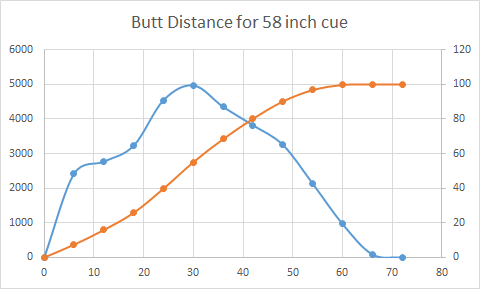
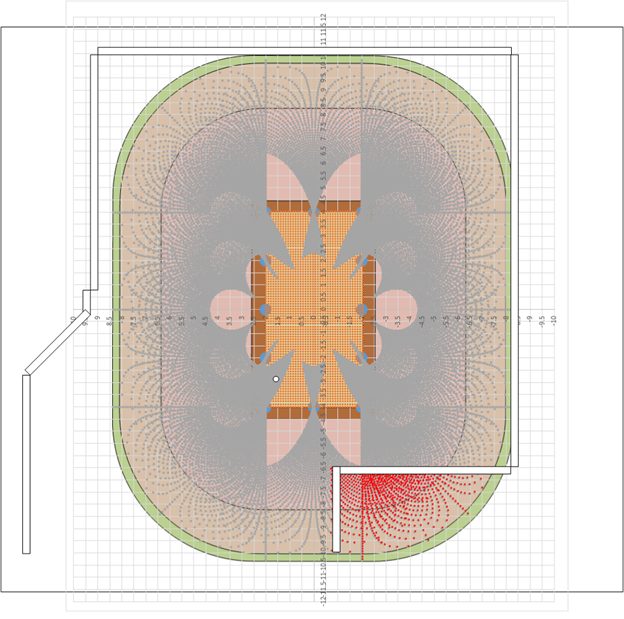
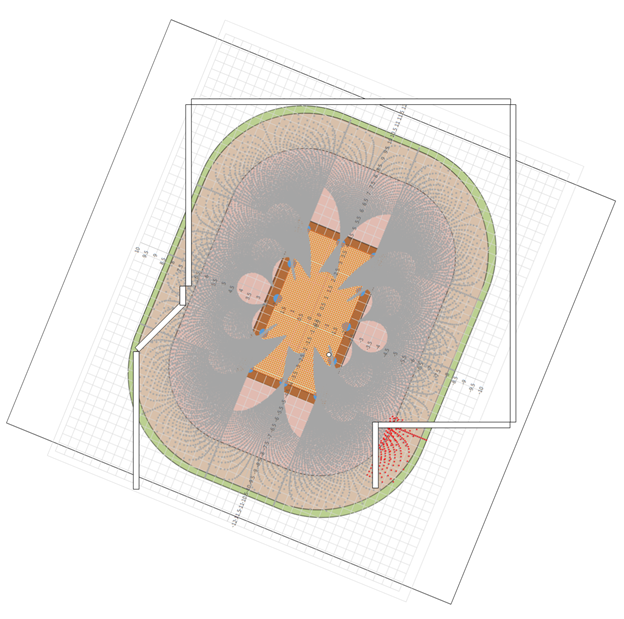
Zeke on 8/12/2014 6:28:18 AM
I urge you to consider some carpentry as an alternative.
Why not move a wall? If it's the foundation that is in the way on all four sides, only the option you suggest is apropos. But if at all possible, opt for a full sized (9x4.5') table coupled with moving one of he two obstruction walls?
I had two choices on my setup: Have a 9' table and have a "seating area" (a stairwell header from below) "obstruction" that blocks players (from the knee down) from taking a "full, upright, clear shot - or, having to put one knee on a shelf/seat for maybe 10% of all shots from that corner area; or - install a 7 to 8-footer.
Like golf, you can play as many holes as you like but if it's going to "count" - 18 holes is what you need.
Likewise, shooting pool on a 7 or 8 footer is better than not playing at all - but a 9-footer is the only one you'll ever see in a pro tournament, and 18-holes is the only number you'll see on tour...
AlP on 9/14/2014 11:57:09 AM
I have considered the options and actually moving the walls was one of the options I had considered. Unfortunately both walls are load bearing walls and to knock down either would require putting in a steel beam header to carry the weight of the second floor of the house. Given the costs and complexity of that remodel, I have decided to start off with the 7 ft table and perhaps upgrade if our family outgrows it.
After visiting Olhausen I am a little more comfortable starting off with the 7 ft table. They very nice folks there mentioned that 7 ft tables are gaining popularity, at least in San Diego anyway, and Olhausen has seen a marked uptick in the number of 7 ft tables they are selling. Also there is a local establishment here that recently pulled out its 9 ft tables in order to put in 7 ft tables so they could have more of them. They host tournaments/league play every night of the week and it always seems to be crowed.
I ended up ordering an Olhausen 7ft Huntington pool table. Should be here in a couple of weeks.
AlP on 10/17/2014 3:07:10 PM
I just wanted to thank everybody for the help. The table has arrived and is in the option two configuration.
Actually, Olhausen was very accommodating of my space problem. I had showed them the diagrams in this post and they ended up letting me try the table in both positions Option 1 and Option 2, option 2 turned out to be MUCH better as the forum community suggested. I will have to give Olhausen 6 out of 5 stars for outstanding customer sales and service. Anyway I thought you may enjoy a couple of pictures of the actual table in its new home.
In option 2, I have been able to play many full 8 ball games without needing the short stick at all. With Option 1 configuration I needed to use the short stick about 3-5 times per 8 ball game.
Thanks again to the forum for all of your help.
Zeke on 10/17/2014 7:25:28 PM
Excellent!
Enjoy it!
 billiardsforum on 9/25/2015 5:08:15 AM
billiardsforum on 9/25/2015 5:08:15 AMAIP - any chance you could share the spreadsheet you used to model the playable shots according to cue lengths?
Putting a Pool Table in a Small Area
- Title: Putting a Pool Table in a Small Area
- Author: AlP
- Published: 7/15/2014 9:33:43 PM

